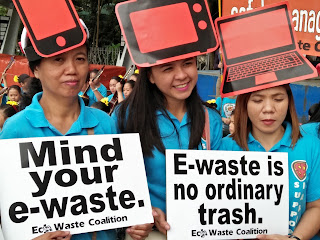Holiday Reminder: Prevent, Reduce and Safely Manage Your E-Waste
With holiday shopping in full swing, a toxics watch group
wasted no time in reminding consumers to think about public health and the
environment as electrical appliances and electronic gadgets are replaced with
something new and eventually discarded.
To promote e-waste prevention, reduction and safe management, the non-profit
EcoWaste Coalition today conducted a public outreach at Quezon Memorial Circle
to inform the public about e-waste, which is described as “one of the fastest
growing waste streams” across the globe.
The event followed the release last December 13 of the Global E-Waste Monitor
2017 by the International Telecommunication Union, United Nations University
and the International Solid Waste Association indicating the rising levels of
e-waste and its improper and usafe treatment and disposal through burning or dumping. Globally, some 44.7 million metric tonnes of
e-waste were generated in 2016 or 6.1 kg per inhabitant. Filipinos produced 2 to 5 kg of e-waste per inhabitant,
according to the report. Experts
estimate that e-waste generation will reach 52.2 million metric tonnes by 2021.
“Broken appliances, outmoded gadgets, busted lamps and other unwanted
electrical and electronic products that are improperly recycled, burned or
disposed of can pollute the environment with health-damaging chemicals,”
cautioned Thony Dizon, Chemical Safety Campaigner, EcoWaste Coalition.
Among the hazardous substances that make up electrical and electronic equipment
and their wastes are heavy metals such as cadmium, hexavalent chromium, lead
and mercury, and persistent organic pollutants (POPs) such as polybrominated
diphenyl ethers (PBDes) and polychlorinated biphenyls (PCBs), among dozens of
other toxic chemical compounds.
The EcoWaste Coalition explained that reckless disposal practices can result in
the release of these nasty chemicals, some of which like mercury, PBDEs and PCBs
are covered by multilateral environmental agreements like the Minamata
Convention on Mercury and the Stockholm Convention on POPs.
When e-wastes such as vinyl-coated cables are burned to get the copper wire,
harmful byproduct POPs like dioxins and furans are formed and released to the
environment, the group explained. Dioxins are considered as among “the
most toxic chemicals known to science.”
Fluorescent lamps when dumped with ordinary trash or manually dismantled to
remove the metal parts for recycling will release the mercury vapor out of the
glass tubing and cause toxic pollution, the group added. Exposure to
mercury, a potent neurotoxin, can damage the brain and the central nervous
system.
When
the plastic casings of cathode ray tube TVs and computer monitors are
incinerated or landfilled, toxic PBDEs are released contaminating the
environment. PBDEs are among the new POPs targeted for global elimination under
the Stockholm Convention.
During the event, members of the San Vicente Elementary School Children’s Rondalla
played Christmas songs as EcoWaste Coalition volunteers donning headgears with
images of mobile phone, TV, laptop and other electrical and electronic products
drew public attention on the hazads of e-waste.
According to the leaflet “E-Waste ‘to, Iwasto!,” “e-wastes should be returned
to their manufacturers for proper management as an ideal solution.
Otherwise, e-wastes should be managed by accredited treatment, storage and
disposal facility. These can be effectively done by instituting
appropriate drop-off or collection points for their safe and ecological
retrieval/collection, storage, and recycling or disposal.”
The leaflet was prepared by the EcoWaste Coalition for the “Safe PCB and
E-Waste Management Project” of the Department of Environment and Natural
Resources with assistance from Global Environment Facility and the United
Nations Industrial Development Organization.
To avoid and minimize the creation of e-waste this Yuletide season, the
EcoWaste Coalition requested consumers to consider the following tips:
1. Extend the life of your existing electronics instead of buying new ones. Consider whether you truly need to get new ones before rushing to buy the latest stuff.
2.
Have broken electronics repaired.
3.
Have outdated component of an electronic product refurbished or upgraded
instead of buying an entirely new replacement.
4.
Never dispose of unwanted but still usable electronics. Pass them on to
relatives and friends for reuse or donate to charities and schools. What might
be of no use to you, might come in handy for some people.
5.
Collect spent household batteries, cellphone batteries, fluorescent lamps,
empty ink cartridges and the like, label and safely store them in a container
with cover and kept out of reach of children and pets. These should be
safely managed or disposed of in an environmentally-sound manner and not mixed
with regular waste.
6.
Visit the manufacturer’s website or call the dealer to find out if they have a
take-back program or scheme for your discarded electronics.
7.
If you really need to spend for new electronics, choose items with less
hazardous substances, with greater recycled content, with higher energy
efficiency, with longer life span, and those that will produce less waste.
8.
Take good care of your electronic device – whether it’s brand new, refurbished
or hand-me down - as sound maintenance will prolong its lifespan. Read
the instruction manual carefully and get acquainted and trained on easy
fix-it-yourself guide.
9.
Make it a point to have your e-scrap properly recycled by authorized recyclers
so that they don’t end up as e-waste to be thrown away or burned.
-end-Link to the Global E-Waste Monitor 2017
https://www.itu.int/en/ITU-D/Climate-Change/Pages/Global-E-waste-Monitor-2017.aspx








Comments